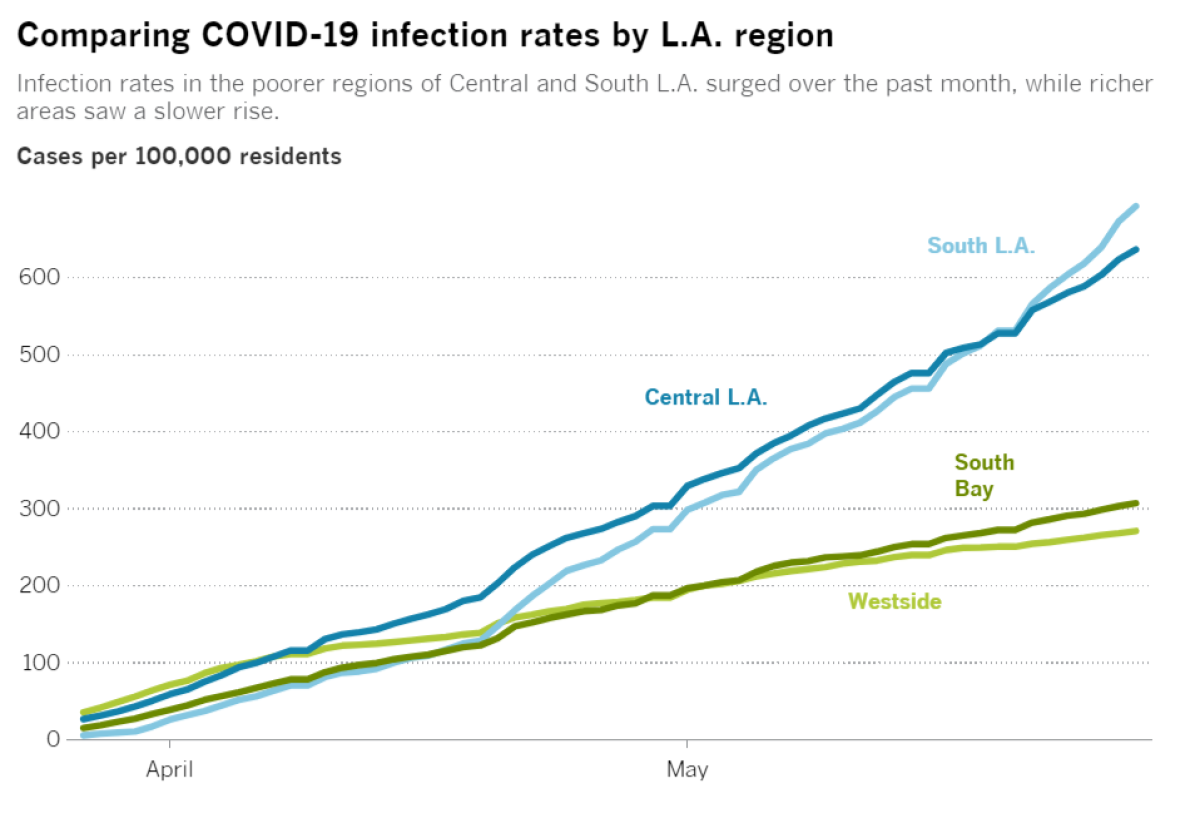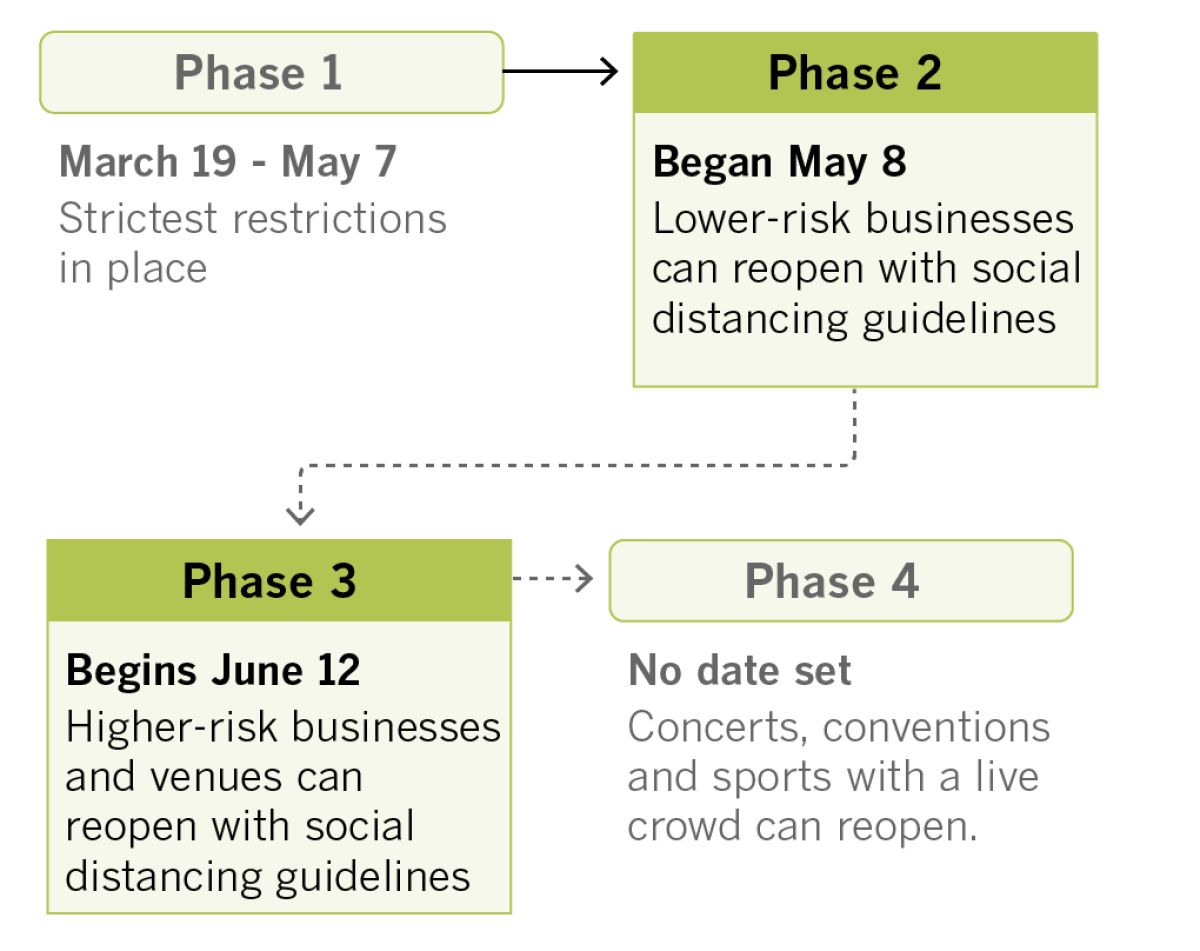Coronavirus Today: A reopening rollback
Good evening. I’m Diya Chacko, and it’s Thursday, May 28. Here’s what’s happening with the coronavirus in California and beyond.
Even as most of California speeds up the pace of reopening this week to lessen the economic fallout from the pandemic, two counties have already tapped the brakes in the face of troubling new data.
Upon the appearance of new coronavirus cases after three months of none reported, Lassen County was the first in the state to re-implement restrictions on in-store shopping, in-restaurant dining, salons and religious services. The remote county of roughly 30,000 bordering Nevada had prided itself on being mostly untouched, but officials said they were aware that the virus might eventually show up. “Unfortunately, this did happen, and we now have a serious problem,” Lassen County’s public health officer said.
Meanwhile, Sonoma County‘s public health officer announced Wednesday a halt to reopening some businesses after a surge in cases tied to workplace transmission and “a few more hospitalizations that make us worried.”
Health officials have stressed that with the easing of stay-at-home orders come potential dangers. Preventing outbreaks depends on people wearing masks, avoiding crowded spaces and keeping at least six feet apart. “More people being around one another can result in more transmission of COVID-19,” said Los Angeles County Public Health Director Barbara Ferrer. “This is why it couldn’t be more important for us to take care of each other when we’re out of our homes.”
With transmission of the virus expected to increase as residents venture out, a Times analysis of L.A. County health data shows a widening gap between infection rates in poor communities and those in wealthy ones. It also shows that a surge in new cases feared by public health officials did come to pass — but was largely concentrated in the areas with a lot of essential workers, more crowded housing and higher rates of underlying health conditions such as asthma, diabetes and heart disease.

Our ability to continue with reopening depends on complete and accurate data. Even with expanded testing, however, workplaces from nursing homes to delivery warehouses are stumbling when it comes to tracking infections in their facilities.
The California health department has issued new instructions to all skilled nursing facilities to test residents and staff and isolate anyone who is positive, especially asymptomatic employees who work in multiple facilities. It’s a move that overrules a more lax testing policy allowed by Los Angeles County, which had instructed homes with no cases that they could skip testing staff and test only 10% of residents weekly.
Amazon workers say the company won’t tell them how many infections there are at warehouses and Whole Foods stores. So employees across the country have taken it upon themselves to do the tracking, fielding private messages, searching social media platforms for reports and updating numbers in Google documents. Not having this data is a “safety hazard,” said the director of a warehouse workers advocacy group, “because they don’t know what level of vigilance to have and what precautions to take.” An Amazon spokesperson said the company does track the information at a site level but does not release the aggregate numbers because they might contain outdated information.
By the numbers
California cases and deaths as of 3 p.m. PDT Thursday:
Track the latest numbers and how they break down in California with our graphics.

See which counties are reopening with our tracker.
Across California
State Senate Democrats are poised to reject $14 billion in budget cuts proposed by Gov. Gavin Newsom, choosing instead to craft a spending plan that looks for other ways to erase the state’s budget gap. The plan, which refuses some of Newsom’s cuts to schools and social services, assumes additional money will come from the federal government by early September.
Officials at the Del Mar Fairgrounds in San Diego County said this week that without crucial financial assistance the state-owned property could be forced to close. The move would have far-reaching economic effects on the region; the San Diego County Fair attracted more than 1.5 million visitors last year, and by itself typically generates more than half of the property’s $87 million in annual revenue. A revised summer horse race schedule has been announced, along with new health and safety measures, but the track is still expected to lose $17 million in revenue from food and beverage, tickets, merchandise and parking, with some of that loss offset by paying fewer employees.
As Hollywood faces mounting pressure to resume work, filmmakers are turning to virtual production, creating digital sets in lieu of shooting on location. Thanks to video games, the technology has advanced well beyond the use of green screens: Actors and crew can now interact in real time within a projected 3-D environment. Producers say this type of production is one way to mitigate the risks — and safety costs — from the coronavirus. “One day you’re shooting a desert scene and the next day you’re shooting a scene in the Arctic and all you ended up doing was some costume changes, but it’s still that same controlled environment,” a VFX supervisor said.
With L.A. County behind many others when it comes to reopening, some black barbershop and salon owners are resuming services in secret to earn money. Others say it’s not worth the risk to their health. “Historically, barbershops have been spaces where black men go to release, to be in community with other black men, to get their hair cut, to look good and feel good,” said the founder of a South L.A.-based nonprofit that trains black barbers to address health issues and run workshops. “When you disconnect that, it’s another form of self-care that we don’t have access to.”
Resources
— For general safety, wash your hands for at least 20 seconds (here’s a super-fun how-to video). Stop touching your face, and keep your phone clean. Practice social distancing, maintaining a six-foot radius of personal space in public. And wear a mask if you leave home. Here’s how to do it right.
— Watch for symptoms including fever, cough, shortness of breath, chills, repeated shaking with chills, muscle pain, headache, sore throat and loss of taste or smell. If you’re worried you might be infected, call your doctor or urgent care clinic before going.
— Here’s how to care for someone with COVID-19, from monitoring their symptoms to preventing the virus’ spread.
— If your job has been affected by the coronavirus pandemic, here’s how to file for unemployment.
— Here are some free resources for restaurant workers and entertainment industry professionals having trouble making ends meet.
— Advice for helping kids navigate pandemic life includes being honest about uncertainties, acknowledging their feelings and sticking to a routine. Here’s guidance from the Centers for Disease Control and Prevention.
— In need of mental health services? Here are resources for coping during the crisis from the CDC and the L.A. County Department of Public Health. L.A. County residents can also call (800) 854-7771 or text “LA” to 741741.
Around the nation and the world
As masks become a political issue, state and local leaders are pushing compliance to help slow the spread of coronavirus. New York Gov. Andrew Cuomo announced Thursday he will sign an executive order allowing private businesses to deny entry to patrons who decline to wear a face covering. “You don’t want to wear a mask? Fine. But you don’t have a right to then go into that store if that store owner doesn’t want you to,” he said.
Under the $2.7-trillion CARES Act, homeowners with government-backed mortgages are entitled to 180 days of forbearance and a 180-day extension. But millions of eligible homeowners were provided inconsistent or confusing information by more than two dozen banks that hold federally backed mortgages, a federal watchdog found. Among the biggest offenders were Bank of America, MidFirst and Truist, which together hold more than $63 billion in federally backed mortgages.
The pandemic has opened up potential avenues of international cooperation, though some of the attempts have been halting. With fears of a second wave of infections looming, some Persian Gulf nations have turned for medical help to an ostensible enemy and a country they don’t officially recognize: Israel. “I wouldn’t say that attitudes have changed in the past 70 days,” said a division head at one of Israel’s top medical institutions, “but we’ve definitely received more and more approaches from different places.”
Your questions answered
Today’s question comes from readers who want to know: How can I find a new apartment rental during the pandemic? Here are some suggestions from reporter Jack Harris.
Despite the shutdown (or maybe even because of it) the rental market is still in motion, even as many other parts of the economy have screeched to a halt. More than two months into many shutdowns, inventory has remained steady.
“I think a lot of people are like, ‘Oh, I’m sitting here in my apartment, and it makes me ready for a change,’” said a director at Apartments.com.
Landlords, from small single-building owners to corporations, are offering safe alternatives to search for a new place. Virtual tours, the most popular new method, take different forms and include 3-D visuals and live video chats with leasing agents. Even before the pandemic, an increasing number of apartments had adopted online lease signings, so the entire process can be done remotely.
If you still want to see a place in person, some landlords have systems to leave keys in drop boxes or with on-site employees.
Got a question? Our reporters covering the coronavirus outbreak want to hear from you. Email us your questions, and we’ll do our best to answer them. You can find more answers in our Frequently Asked Questions roundup and in our morning briefing.
For the most up-to-date coronavirus coverage from The Times, visit our homepage and our Health section, listen to our “Coronavirus in California” podcast and follow us on Twitter and on Instagram.





